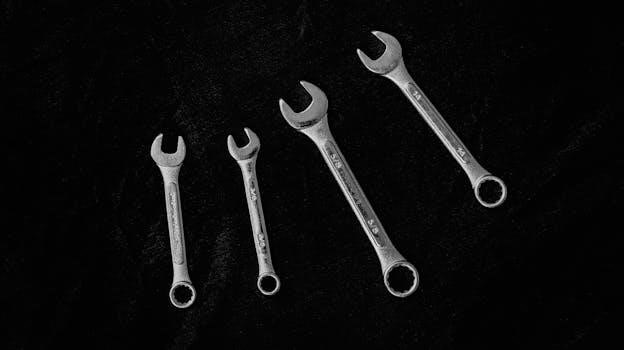Differential Size in Manual Challenger Scat Packs
Manual Dodge Challenger Scat Packs are equipped with a robust 230mm rear differential. This size is consistent across various model years for the manual transmission variant. The 230mm unit is designed to handle the high torque output of the 6.4L V8 engine, ensuring reliable performance.
Standard Rear Differential Size
The standard rear differential size for a manual transmission Dodge Challenger Scat Pack is 230mm. This measurement refers to the diameter of the ring gear within the differential housing. This particular size is consistent across various model years of the Challenger Scat Pack equipped with a manual gearbox, specifically the Tremec TR-6060 transmission. The 230mm differential is designed to effectively manage the substantial power and torque produced by the 6.4-liter HEMI V8 engine. It is a robust unit that has been engineered to withstand the demands of high-performance driving. This size is significant because it contributes to the overall durability and performance of the vehicle’s drivetrain. The 230mm differential housing accommodates the necessary internal components such as the ring and pinion gears, along with the limited-slip mechanism present in manual Scat Packs. This standard size is a key factor in maintaining the vehicle’s intended handling characteristics and power delivery. The consistent use of the 230mm differential ensures compatibility with other drivetrain components and allows for consistent performance across different manual Scat Pack models. It’s a crucial component for transferring power to the rear wheels and maintaining the car’s high-performance capabilities. Understanding this standard size is important for maintenance and potential upgrades.
Gear Ratio of Manual Scat Pack
The gear ratio for the manual transmission Dodge Challenger Scat Pack is a crucial aspect of its performance. These models come equipped with a 3.90 gear ratio in their rear differential. This ratio is specifically chosen to complement the characteristics of the 6.4-liter HEMI V8 engine and the Tremec TR-6060 manual transmission. A 3.90 gear ratio means that the driveshaft will rotate 3.90 times for every one rotation of the rear wheels. This lower gear ratio provides a significant mechanical advantage, resulting in quicker acceleration and a more aggressive driving experience. The 3.90 ratio is a key factor in delivering the Scat Pack’s impressive off-the-line performance. This gear ratio is standard for manual transmission Scat Packs, ensuring consistency across different model years. The 3.90 ratio works in conjunction with the transmission’s gear ratios to optimize the engine’s power delivery to the wheels. This particular gear ratio is a hallmark of the manual Scat Pack, differentiating it from the automatic models which have a different gear ratio. The 3.90 ratio also contributes to the overall engaging driving experience that manual Scat Pack owners appreciate. It provides a balance of acceleration and top-end performance, making it suitable for both street and track use.
Limited-Slip Differential (LSD)

The manual Dodge Challenger Scat Pack comes standard with a performance-tuned, asymmetric limited-slip differential (LSD). This LSD is a crucial component that enhances the car’s handling and traction capabilities, particularly during spirited driving. Unlike an open differential, which allows one wheel to spin freely while the other remains stationary, an LSD actively distributes torque to both rear wheels. This feature is especially beneficial when accelerating out of corners or on surfaces with varying traction. The asymmetric design of the LSD means that it is tuned to behave differently during acceleration and deceleration. This is achieved through the use of clutch packs that engage to transfer power to the wheel with the most grip. The LSD minimizes wheel slip, which is essential for maximizing the car’s acceleration. The result is improved cornering stability and enhanced control. The inclusion of an LSD is a significant factor in the Scat Pack’s performance, allowing drivers to confidently push the car to its limits. This LSD works effectively with the car’s suspension and chassis to provide a well-balanced driving experience. The limited-slip differential is a standard feature for all manual transmission Scat Packs, reinforcing its performance-oriented design. It is a key element that distinguishes the Scat Pack from lower trim models with open differentials.

Axle Size Considerations
When discussing the differential in a manual Challenger Scat Pack, axle size is a crucial element to consider. The manual Scat Pack typically utilizes a 230mm differential, which is paired with specific axle dimensions. These axles are designed to work in conjunction with the 230mm differential to effectively transfer the engine’s power to the wheels. It’s important to note that axle size can vary between different Challenger models and transmissions. For instance, automatic transmission models may have different axle specifications than their manual counterparts. The 230mm differential and its compatible axles are engineered to handle the high torque output of the 6.4L V8 engine. When considering aftermarket upgrades or replacements, it’s crucial to ensure compatibility with the existing axle setup. Mismatched axle sizes can lead to improper fitment and potential damage to the differential or other drivetrain components. Therefore, when purchasing new components, it’s recommended to check parts compatibility. In some cases, changing the differential might require axle swaps too. Always verify the correct specifications to maintain the integrity of the vehicle; The 230mm differential and the corresponding axle size are a key part of the Scat Pack’s performance package, ensuring durability and reliability.
Comparison with Automatic Scat Pack
When comparing the manual Challenger Scat Pack to its automatic counterpart, a key difference lies in the differential and its gear ratio. While both models utilize a 230mm differential, the automatic version typically features a 3.09 gear ratio, whereas the manual version comes with a 3.90 gear ratio. This difference in gear ratio significantly impacts the driving experience and performance characteristics of each model. The automatic Scat Pack’s 3.09 ratio is designed to work in conjunction with the automatic transmission’s torque multiplication capabilities, providing a balance between acceleration and highway cruising efficiency. Conversely, the manual Scat Pack’s 3.90 gear ratio, combined with a limited-slip differential, enhances acceleration and provides a more engaging driving experience. This difference in gear ratios also affects the overall feel and performance of the vehicle, with the manual version generally having quicker acceleration due to the more aggressive gearing. Additionally, the automatic transmission usually uses a different type of limited slip differential compared to manual ones. Understanding these differences is crucial for enthusiasts when considering which transmission and differential setup best suit their driving style and preferences. The gear ratio and differential selection are integral parts of each model’s design, influencing how power is delivered to the wheels.
Fluid and Additive Requirements
Maintaining the differential in a manual Challenger Scat Pack requires using the correct fluid and additives to ensure optimal performance and longevity. Typically, a 75W-90 gear oil is recommended for the rear differential in manual Scat Packs. This viscosity grade provides the necessary lubrication and protection for the gears and bearings under high-stress conditions. However, it’s crucial to verify the specific recommendations in the owner’s manual for your particular model year, as there may be slight variations. Furthermore, a limited-slip differential (LSD) additive is usually required. This additive helps to reduce gear chatter and ensures the smooth operation of the LSD clutches. Without the proper additive, the differential may exhibit noises or reduced effectiveness. It’s essential to use a high-quality, GL-5 rated gear oil that is compatible with limited-slip differentials. Always adhere to the manufacturer’s recommended fluid change intervals and additive requirements. Failure to use the correct fluids and additives can lead to premature wear, increased noise, and potential damage to the differential. Always check the latest service information for the most up-to-date recommendations.
Aftermarket Differential Options
For Dodge Challenger Scat Pack owners seeking enhanced performance beyond the stock setup, the aftermarket offers a variety of differential upgrades. These options can improve traction, handling, and overall driving experience. One common upgrade is a more aggressive limited-slip differential (LSD) that provides increased locking capability, transferring more power to the wheel with the most grip, especially beneficial for track days. Some aftermarket differentials also offer adjustable preload settings that let drivers fine-tune the LSD’s behavior for different driving styles and conditions. Furthermore, there are stronger differential housings and components made from reinforced materials, designed to withstand the rigors of high horsepower and intense usage. These upgrades are particularly appealing to enthusiasts who frequently engage in drag racing or other forms of performance driving. Some specialized aftermarket options may also offer different gear ratios than the factory setup, allowing for fine-tuning acceleration and top-speed characteristics. When considering aftermarket differential upgrades, it’s critical to select components from reputable manufacturers to ensure reliability and proper fitment. Professional installation is generally recommended for these modifications.
Installation Considerations
Installing or replacing a differential in a Dodge Challenger Scat Pack, especially the manual transmission variant, requires careful attention to detail and often, specialized tools. It’s crucial to ensure proper alignment and torque specifications when mounting the differential to the chassis to prevent noise or vibration. The process usually involves disconnecting the driveshaft, axle shafts, and potentially, the exhaust system; If you’re changing the differential itself, you must also correctly handle the gear lash and pinion depth. It’s important to use high-quality lubricants and seals during reassembly to maintain the system’s integrity. Additionally, proper torque of all bolts is essential for safe and reliable operation. For those lacking experience in drivetrain work, it is strongly recommended to seek professional assistance to avoid accidental damage, which could lead to costly repairs. Incorrect installation could result in poor handling, premature wear, or even catastrophic failure. If you’re considering a performance upgrade, ensure all components work harmoniously together.
Model Year Variations

While the core differential size of 230mm remains consistent across manual Dodge Challenger Scat Packs, there can be subtle variations in specific components or tuning based on the model year. For instance, earlier models might have slightly different internal gear designs or material compositions compared to later versions. Additionally, the specific limited-slip differential (LSD) unit might see minor upgrades or refinements over time. It’s crucial to check the original equipment manufacturer (OEM) part numbers to verify compatibility when replacing any parts. These numbers ensure that the replacement is an exact fit and maintains the performance characteristics of the original differential. Some model years might have specific software calibrations for the stability control system that are linked to the differential’s characteristics; therefore, using the correct differential is very crucial. While the 230mm size remained constant, the manufacturer may have made subtle changes that can affect overall performance. Always confirm the specific part number for your model year.
Performance Implications of Differential Choice
The choice of differential significantly impacts the performance of a manual Dodge Challenger Scat Pack. The 3.90 gear ratio, typically found in manual models, is designed for enhanced acceleration and responsiveness. This lower gear ratio allows the engine to reach its peak power band quicker, resulting in faster launches and improved overall speed. However, it can slightly decrease fuel efficiency at high cruising speeds. The limited-slip differential (LSD) helps distribute power evenly to both rear wheels, improving traction and reducing wheel spin during hard acceleration or cornering. This feature is critical for maximizing the car’s performance potential. An open differential, unlike an LSD, would allow one wheel to spin freely when traction is lost, leading to diminished acceleration. Therefore, the factory-installed LSD in manual Scat Packs is essential for optimal handling and performance. Additionally, the choice of differential fluid and additives can also influence performance, ensuring smooth operation and reducing wear. The proper differential choice ensures that power is delivered efficiently.

